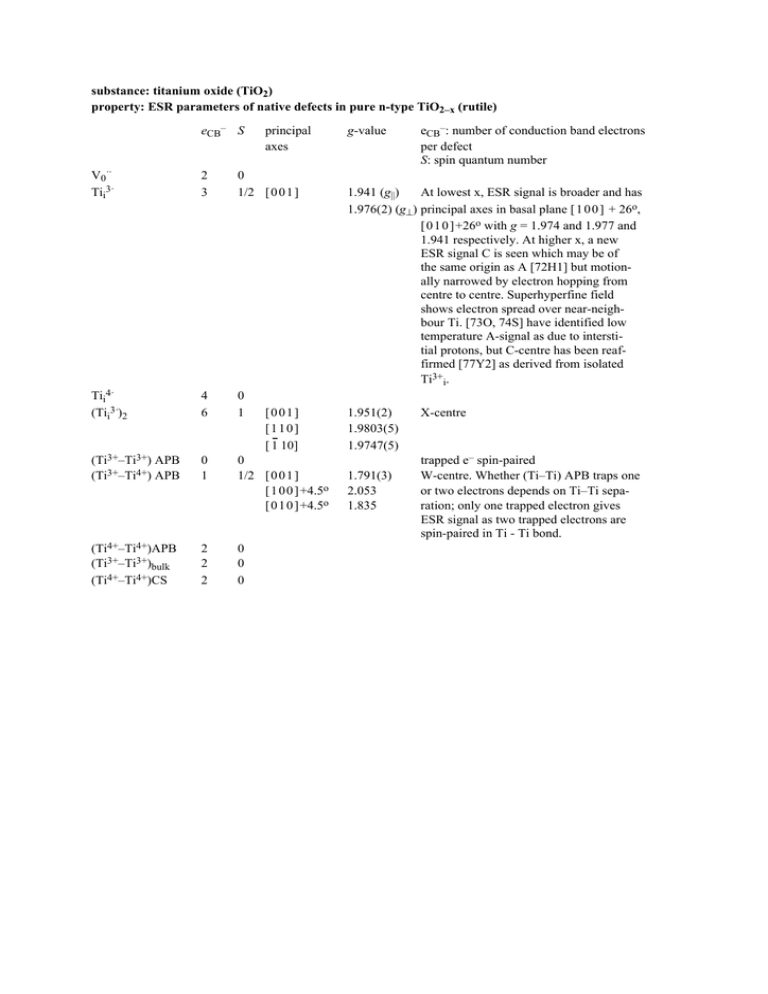substance: titanium oxide (TiO ) (rutile)
advertisement

substance: titanium oxide (TiO2)
property: ESR parameters of native defects in pure n-type TiO2–x (rutile)
eCB– S
principal
axes
V0··
Tii3·
2
3
0
1/2 [ 0 0 1 ]
Tii4·
(Tii3·)2
4
6
0
1
(Ti3+–Ti3+) APB
(Ti3+–Ti4+) APB
0
1
0
1/2 [ 0 0 1 ]
[ 1 0 0 ]+4.5o
[ 0 1 0 ]+4.5o
(Ti4+–Ti4+)APB
(Ti3+–Ti3+)bulk
(Ti4+–Ti4+)CS
2
2
2
0
0
0
[001]
[110]
[ 1 10]
g-value
eCB–: number of conduction band electrons
per defect
S: spin quantum number
1.941 (g||)
At lowest x, ESR signal is broader and has
1.976(2) (g⊥) principal axes in basal plane [ 1 0 0 ] + 26o,
[ 0 1 0 ]+26o with g = 1.974 and 1.977 and
1.941 respectively. At higher x, a new
ESR signal C is seen which may be of
the same origin as A [72H1] but motionally narrowed by electron hopping from
centre to centre. Superhyperfine field
shows electron spread over near-neighbour Ti. [73O, 74S] have identified low
temperature A-signal as due to interstitial protons, but C-centre has been reaffirmed [77Y2] as derived from isolated
Ti3+i.
1.951(2)
1.9803(5)
1.9747(5)
1.791(3)
2.053
1.835
X-centre
trapped e– spin-paired
W-centre. Whether (Ti–Ti) APB traps one
or two electrons depends on Ti–Ti separation; only one trapped electron gives
ESR signal as two trapped electrons are
spin-paired in Ti - Ti bond.
Fig. 1 shows the variation of ESR signal intensity with oxygen deficit. The low-temperature A-signal is not
intrinsic [74S] but associated with interstitial hydrogen, and the so-called vacuum reduction of TiO 2 can only be
effected in vacuum system with residual impurities; TiO2 cannot be reduced by heating in a clean vacuum
[73O]. The weight of ESR evidence is nevertheless in favour of interstitial Ti rather than V 0·· at moderate (x ≈
10–4) deviations from stoichiometry and possible interstitial sites are shown in Fig. 2. Other evidence for
interstitials derives from proton channeling experiments [77Y1] on "vacuum reduced" TiO 2.
Ordered defects exist on shear planes [69B, 77Y2]. At low defect concentrations the main defect line is along
[312] (Fig. 3) and isolated planar {312} defects have been found for x ≥ 0.001. The (312) CS planes show a net
attraction (Fig. 4) and at higher deviation from stoichiometry they order to produce higher members of the
homologous series TinO2n–1 (15 ≤ n ≤ 37) [69B, 71B1, 71B2]. As n decreases the shear planes are observed to
swing around to (121) via a very large number of intermediate orientations (hkl) that can be resolved into (hkl) =
p(121) + q(011) = (p, 2p+q, p+q) (p, q integers). This "swinging process" has little effect on the CS separation,
and its onset appears to be at x ≈ 0.05 though work on (Ti,Cr)O2–x suggests that CS swinging commences at
much smaller values of x (≈ 0.02) in this system.
The type of defect formed as well as the level of ordering depends critically on the purity and previous history of
the sample, and reproducible results are only obtained for samples annealed under controlled conditions for
lengthy periods. The ubiquity of interstitial hydrogen revealed by EPR may also be of considerable significance.
Apparently reduction by CO/CO2 mixtures rather than by "vacuum" can arrest the formation of shear planes
[80B] though this surprising result lacks confirmation.
References:
69B
71B1
71B2
72B
72H1
72H2
73K
73O
74S
77Y1
77Y2
80B
Bursill, L. A., Hyde, B. G., Teresaki, O., Watanabe, D.: Philos. Mag. 20 (1969) 347.
Bursill, L. A., Hyde, B. G.: Acta Crystallogr. 827 (1971) 210.
Bursill, L. A., Hyde, H. G.: Philos. Mag. 23 (1971) 3.
Bursill, L. A., Hyde, H. G.: Prog. Solid State Chem. 7 (1972) 177.
Hasiguti, R.: Adv. Mater. Sci. 2 (1972) 69.
Horn, M., Schwertfeger, C. F., Meagher, E. P.: Z. Kristallogr. 136 (1972) 273.
Kersson, J., Volger, J.: Physica 69 (1973) 535.
Ohlsen, W. D., Johnson, O. W.: J. Appl. Phys. 44 (1973) 1927.
Shen, L. N., Johnson, O. W., Ohlsen, W. D., DeFord, J. W.: Phys. Rev. B10 (1974) 1823.
Yagi, E., Koyawa, A., Sakairi, H., Hasiguti, R. R.: J. Phys. Soc. Jpn. 42 (1977) 939.
Yagi, E., Hasiguti, R. R.: J. Phys. Soc. Jpn. 43 (1977) 1998.
Blanchin, M. G., Faisiant, P., Picard. C., Ezzo. M. . Fontaine. G.: Phys. Status Solidi (a) 60 (1980) 357.
Fig. 1.
TiO2. Concentration of various lattice defects in slightly reduced rutile vs. oxygen deficit Od (left ordinate spin
concentration, right ordinate internal friction peak) [72H1].
Fig. 2.
TiO2. Crystal structure of rutile showing some [1/2,0,1/2] and [1/2,0,1/4] types of interstitial site. Substitutional
(S) and interstitial (I) site distances to oxygen atoms are: AS = 1.944 Å, BS = 1.988 Å, AI = 2.184 Å, BI = 1.603
Å (a = 4.594 Å, c = 2.959Å) [73K].
Fig. 3.
TiO2. Projection of rutile lattice onto the (001) plane intersected by a (312) fault. Ti-ion pairs PQ about the fault,
and a single electron trapped at this site produces a W-centre EPR spectrum [77Y2]. R: Ti–Ti displacement.
Fig. 4.
TiO2. Schematic empirical interaction energy between a pair of (312) CS-planes: wave function Ψ(i,j) vs. plane
separation D0 [72B].


